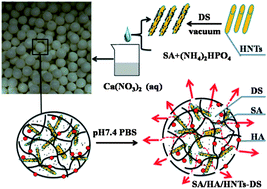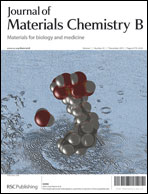In situ generation of sodium alginate/hydroxyapatite/halloysite nanotubes nanocomposite hydrogel beads as drug-controlled release matrices†
Abstract
Diclofenac sodium-loaded sodium alginate/hydroxyapatite/halloysite nanotubes (SA/HA/HNTs–DS) nanocomposite hydrogel beads were prepared by the in situ generation of HA nanoparticles during the sol–gel transition of the SA/HNTs suspension. The nanocomposite beads were characterized by FT-IR spectroscopy, thermogravimetric analysis and field emission scanning electron microscopy, etc. Factors, e.g., the weight ratio of HNTs to SA (mHNTs/mSA), the weight ratio of (NH4)2HPO4 to SA (m(NH4)2HPO4/mSA), and the concentration of SA, which influenced the entrapment efficiency (EE) and release of DS, were investigated. The EE was enhanced from 62.85 ± 0.29% to 74.63 ± 1.65%, and the burst release of DS was overcome by introducing appropriate amounts of HA and HNTs. An almost constant rate release of DS is achieved when mHNTs/mSA = 0.3 and m(NH4)2HPO4/mSA = 0.1. The release rate of DS from the SA/HA/HNTs–DS beads was 9.19 mg g−1 h−1. The release of DS is controlled by Case-II transport. The tubular structure of the HNTs and the in situ-formed HA nanoparticles can restrict movability of the SA polymer chains, which is the main reason for the improved drug loading and release behavior.


 Please wait while we load your content...
Please wait while we load your content...